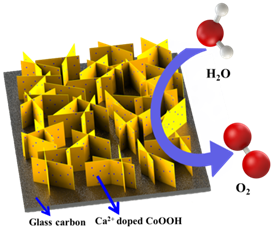It is critical for the development of highly efficient oxygen evolution reaction (OER) electrocatalysts because its sluggish reaction kinetics usually hinders the efficiency of water electrolysis for generating H2. In order to address this issue, Liu’s group try to study catalystic mechanism of cobalt based coordination polymers for OER and enhance corresponding activity.

we demonstrate that ultrathin cobalt based coordination polymers (Co-CPs) plates are exceptional electrocatalysts for OER by showing one of the most low tafel slopes among cobalt based OER catalysts reported so far. It is showcased that Co-CPs can be transformed into Co(OH)2 hexagonal nanoplates and then further oxidized into CoOOH, which act as catalytic active sites for water oxidation. Interestingly, Ca2+, an inactive ion, when introduced in the precursors, thinner CoOOH nanosheets with more exposed active sites are formed, which displaying much higher OER activity than that of Co-CPs. Furthermore, the content of Ca2+ in Co based coordination polymers (CoxCay-CPs) and their corresponding OER activity are systematically investigated with Co0.89Ca0.11-CPs exhibiting the highest OER activity. This work provides fundamental understanding of catalytic mechanism of cobalt based coordination polymers electrocatalysts and the effect of inactive species such as Ca2+ for OER in alkaline electrolyte, which might favor the design of highly active electrocatalysts.